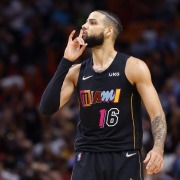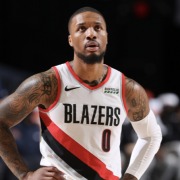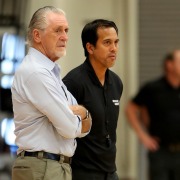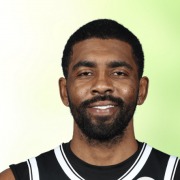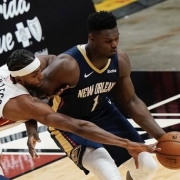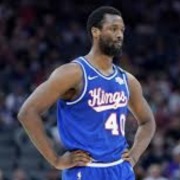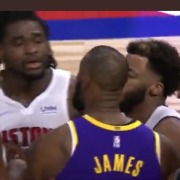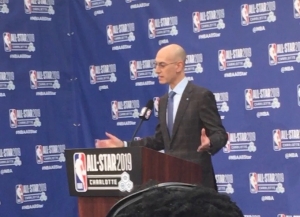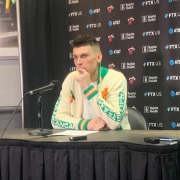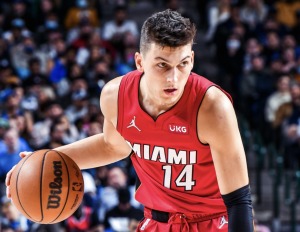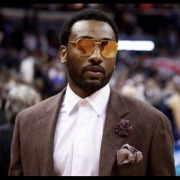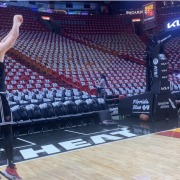The Undeniable Rise of Caleb Martin
For many, just one opportunity is all they need to show the world what they can do. For Caleb Martin, it was about opportunity and the right team at the right time.
Caleb Martin was a late addition to the Miami Heat roster. Hell, he’s still not technically even on the official roster as it stands. But that last-second acquisition via a Two-Way Contract was more important than anyone on the Heat staff could have predicted. No one paid much mind to it and many on social media wondered why the team didn’t use a veteran minimum deal on a player like Wesley Matthews. While the move may have been partly to avoid the repeater tax, it made sense.
There’s a lot of CBA lingo I could get into, but the gist of it is Miami wants to maintain future flexibility by avoiding going into the repeater tax right now. It was frustrating at the time for many fans. I thought it was a decent buy-low move but can understand why some wouldn’t see it as such. Charlotte isn’t a huge market and the few that did know about Caleb would have preferred his brother.
The Heat have already learned their lesson of using end-of-rotation spots on journeymen past their prime. So long are the days of Eddie House, Amare Stoudamire, and Eddy Curry. The team now mostly uses those spots to develop younger unheralded guys who have yet to unlock their full potential. Players like Duncan Robinson, Gabe Vincent, and Max Strus. They want to take the clay that other teams discard and start molding them into a vase good enough for a museum.
Caleb was weighing various non-guaranteed Two-Way offers before getting the call that the Heat wanted him in for a workout. He would leave quite an impression on the Miami brass that included Pat Riley and Erik Spoelstra. The workout was enough for the team to offer him a Two-Way, the same as every other team that wanted his services. The difference was that Martin knew the Heat’s reputation of taking in undrafted players like him and putting them in the best position to succeed. The organization let its reputation speak for itself and landed a project wing.
What the Heat didn’t envision was Martin contributing as much as he has so fast. I imagine they expected to have him play spot minutes waiting on Victor Oladipo’s eventual addition to the team. It seemed to look that way as he garnered only 8 (garbage time) minutes total through the first 5 games. But as is the nature of the league, injuries occurred and Caleb was called upon more and more.
Here is @BradyHawk305 casually slipping in “1v1” to @Calebmartin14 pic.twitter.com/1IPN3AnCNa
— Five Reasons Sports (@5ReasonsSports) January 14, 2022
You’d think with more responsibility and a heavier workload that a Two-Way player would show why he was passed on by so many teams. It’s turned out to be quite the opposite for the versatile wing from Nevada. Martin has showcased every improved tool in his bag and more during this opportunity. His athletic downhill activity and versatility were facets the Heat had only had in Oladipo’s 4 games last season.
Martin has given them what Derrick Jones Jr used to but with an actual handle and ability to shoot. That shot-in-the-arm athleticism that only Bam Adebayo would give them. The Heat added a player that replicated the description of so many of the players on the Suns team that went to the Finals last year.
These skills didn’t appear overnight either. Caleb’s shooting has obviously improved steadily since he’s arrived. The handle and ability to break down a defender one on one while avoiding too many turnovers. He’s also learned to reign in his hyperactivity at the right times. Early in the season, you would see him cutting and standing where a teammate was occupying space. Caleb’s motor would stay on maximum overdrive at times but he’s learned little by little to let the game slow down.
That motor is still being used to its full potential on the defensive end. Watching him fly around on that end has been a joy to watch. Martin has been causing chaos and headaches for opposing guards night in and night out. He doesn’t care who Coach Spoelstra asks him to defend, he’s going to wreak havoc like Marlon Wayans in any scene he’s ever been in. That part of his game is more of a testament to the development he’s done before even getting to Miami. Caleb himself spoke about how he was always the scorer dating back to High School. He’s been adapting to what’s asked of him for quite a while already.
🚨 @5OTF_ 🚨@Calebmartin14 joins to discuss his breakout season, preferred Heat fishing partners, new nickname, Jimmy Butler simulations & more!
Sponsored by @CityCigarLoung1, Salas (5RSN), @ThrpstPreferred (5RSN), @PrizePicks (five) @BetUS_Officialhttps://t.co/melsSG6jUN
— Five Reasons Sports (@5ReasonsSports) January 14, 2022
And he’s still learning on the fly as he’s been thrown into the fire. I don’t think he expected to start 9 games while averaging 30 minutes a game. But there’s no denying he’s taken the challenge head-on and full throttle. In his starts this season he’s putting up 14/5 on 54/42/73 shooting splits. A run of starts that included putting up 28 points on 9/12 shooting. It’s not only a challenge but an opportunity. Caleb knows this is where he could make an impression on not only the Heat but the whole NBA. Showing to everyone that he belongs and that he deserves a legitimate long-term NBA contract. He’s made it hard to ignore and it’s inevitable that the Heat will convert his deal when the tax date is up.
Martin knew Miami was the best spot for him to showcase and establish his place in the league. Miami was looking for a player like Caleb and he fell right into their lap. Maybe it wouldn’t have been as easy had Miami not made a name for itself as a development hub for undrafted and unheralded players. Caleb could have chosen to go elsewhere; it’s not like the Heat offered him a bigger deal than those other teams.
Martin and Miami caught each other at the perfect time and now they’re both reaping the benefits. He’s made it a no-brainer that he’ll get minutes once all the big 4 starters are healthy at once. Someone will have to take those minutes from him and I think Erik Spoelstra knows that. He prefers a versatile player like Caleb as opposed to a specialist. Players that fit his description are more valuable in playoff settings, especially ones that could involve the Nets or the Bulls.
It takes a lot to win a title and that includes hitting on value contracts as you pay your max-level stars. Martin was expected to be an infield single, but he’s been an inside-the-park home run. A regular home run isn’t chaotic and hard enough for a guy like Caleb.
******
Everything Tradeshows is a one-stop-shop for trade show exhibit rentals and custom exhibit display purchase solutions to companies of all sizes.
Visit them at EverythingTradeShows or call 954-791-8882
